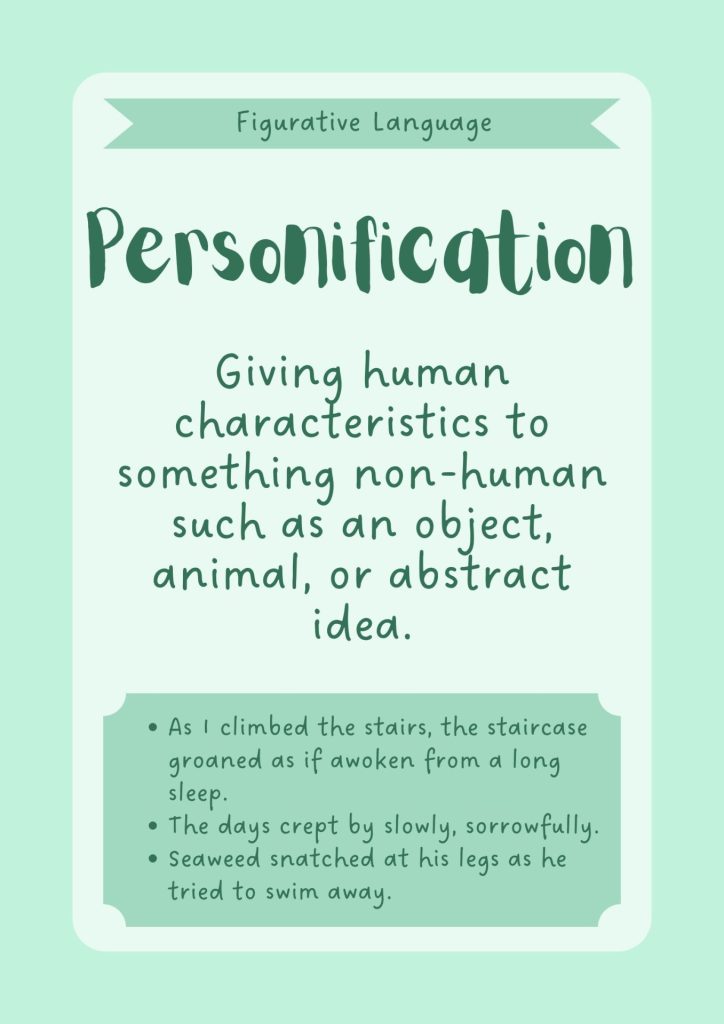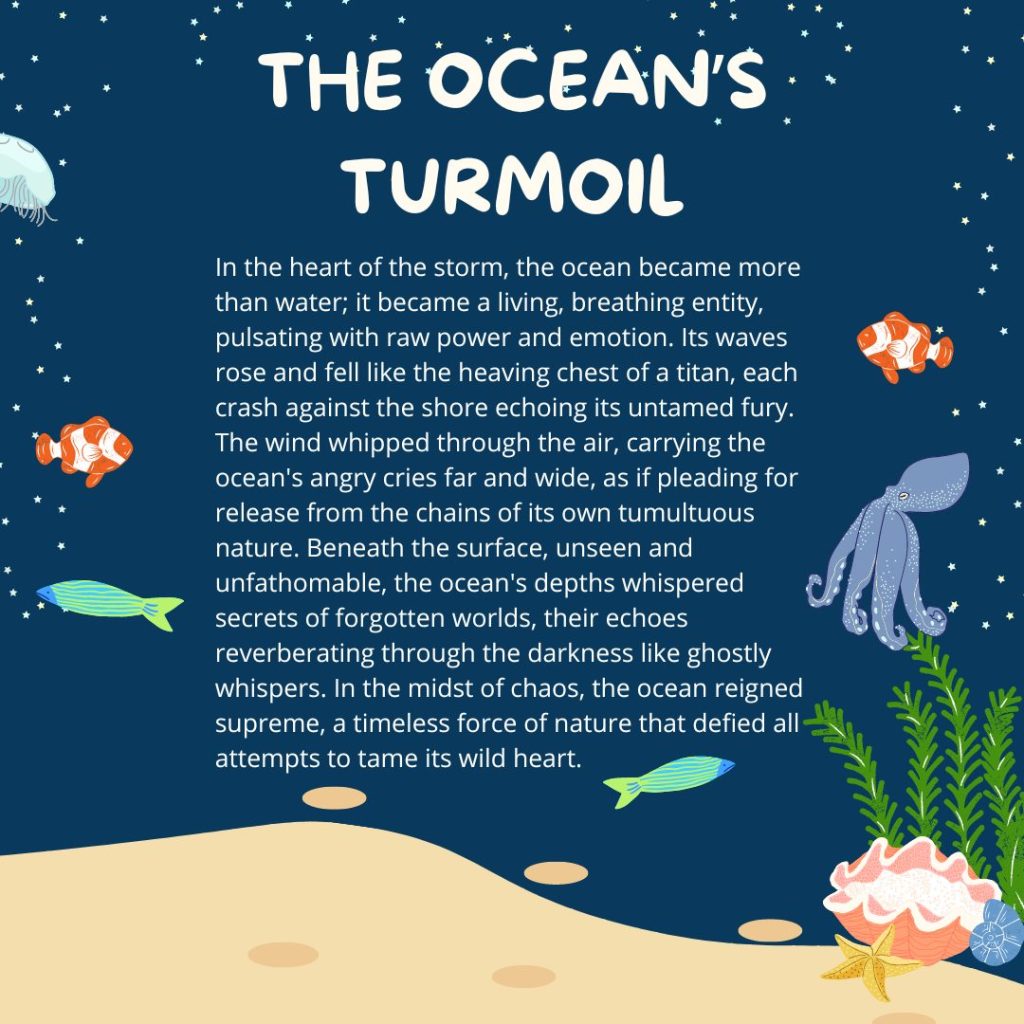Understanding The Art of Personification: Meaning and Examples
Table of Contents
Introduction
Personification
Personification is a powerful figure of speech that breathes life into non-human entities, making them relatable and engaging. Let’s delve into the world of personification and unravel its significance in literature.
Analogy of Definition
What is Personification?
Personification involves infusing non-human entities with human-like qualities, breathing life and personality into them. It serves as a creative and expressive way to convey emotions and ideas.

Method
The Magic of Personification
Writers employ personification to evoke emotions, create vivid imagery, and convey abstract concepts in a tangible and relatable manner. It adds depth and creativity to the writing, captivating the readers’ imagination.
In literature, personification dances across the pages, enchanting readers with its magic. In William Shakespeare’s ‘Macbeth,’ the ominous line ‘Stars, hide your fires; Let not light see my black and deep desires’ personifies the stars, imbuing them with the ability to hide their light, echoing Macbeth’s desire to conceal his dark ambitions. Here, personification transforms the stars into silent witnesses, heightening the drama and adding depth to the character’s inner turmoil.
Here are few more instances wherein personification made timeless literary pieces more vibrant.
- In “Ode to the West Wind” by Percy Bysshe Shelley: “O wild West Wind, thou breath of Autumn’s being…” Here, the wind is personified as a wild entity with the power of breath, embodying the essence of autumn.
- In “The Road Not Taken” by Robert Frost: “Two roads diverged in a yellow wood…” The roads are personified as having the ability to diverge, implying a choice and agency, though they are merely paths.
- In “To Autumn” by John Keats: “Close bosom-friend of the maturing sun…” Autumn is personified as a bosom-friend of the sun, suggesting a close and intimate relationship between the season and the sun’s warmth.
- In “The Love Song of J. Alfred Prufrock” by T.S. Eliot: “The yellow fog that rubs its back upon the window-panes…” The fog is personified as having the action of rubbing its back against the window-panes, giving it a cat-like quality.
- In “The Raven” by Edgar Allan Poe: “And the silken, sad, uncertain rustling of each purple curtain…” The curtains are personified as being uncertain and making a sad, silken rustling, evoking a sense of eerie atmosphere.
How to Use Personification?
Using personification in your writing can add depth, emotion, and vividness to your descriptions. Here are some tips to help you incorporate personification into your own writing:
Identify the Object or Concept: Choose an object, concept, or phenomenon that you want to personify. It could be anything from nature elements like the wind or the sun to abstract concepts like time or death.
Let’s try and form our very own piece incorporating each step. We will choose ocean to personify. The vastness and mystery of the ocean make it an excellent candidate for personification.
Consider the Context: Think about the mood, tone, and overall theme of your writing. How can personifying the chosen object enhance or complement these elements? Tailor your personification to suit the context of your piece.
The context of our piece will be set on a stormy night, where the ocean’s wild nature can be highlighted. The mood will be one of turmoil and uncertainty, reflecting the chaos of the storm.
Use Descriptive Language: When personifying an object, use descriptive language to evoke sensory imagery and create a vivid picture in the reader’s mind. Think about how the object looks, sounds, feels, and behaves as if it were a person.
To add depth to out piece of ocean, we can do in the following way, ‘The ocean roared with fury, its waves crashing against the rugged cliffs like a relentless battering ram. Each crest surged forward with a thunderous roar, spraying salty foam into the air like angry tears. In the darkness of the night, the ocean seemed to stretch endlessly into the unknown, its depths shrouded in mystery and danger.’
Create Metaphors and Similes: Personification often involves using metaphors and similes to compare the object to human attributes or actions. For example, you might compare the movement of a river to the graceful dance of a ballerina or the sound of thunder to the roar of an angry lion.
To potray the image of an ocean and add element of turmoil, we can cleverly use metaphors and similes. Let’s look at how our piece looks by incorporating them, ‘The ocean’s rage was like a tempestuous beast, unleashing its wrath upon the unsuspecting shores. Its currents churned and twisted like the dance of a frenzied whirlwind, pulling everything into its tumultuous embrace. Lightning streaked across the sky, illuminating the ocean’s fury like the fiery breath of a dragon.’
Be Consistent: Once you’ve introduced personification into your writing, maintain consistency in how you portray the object throughout your piece. Avoid mixing metaphors or switching between different human attributes.
In our case, throughout the piece, we shall maintain the portrayal of the ocean as a powerful and unpredictable force of nature. We will avoid sudden shifts in tone or characterization that would detract from the overall personification.
Revise and Edit: Like any other literary device, personification requires careful revision and editing. Read through your writing to ensure that the personification enhances your message and contributes to the overall impact of your piece.
After drafting the piece, we review it carefully to ensure that the personification of the ocean enhances the imagery and contributes to the mood of the scene. We will make any necessary revisions to strengthen the impact of the personified elements.
Here’s the final piece which we created

Examples
Example 1: ‘The wind whispered secrets through the trees.’.
In the sentence, the wind, a natural force, is given the human quality of whispering, which is something people do when they speak softly. This suggests that the wind is communicating secrets, which is also a human-like action.
Example 2: ‘The sun smiled down on the earth.”
In the sentence, the sun, an inanimate object, is described as smiling, a human expression of happiness. It’s as if the sun is pleased or benevolent toward the earth, which is not something the sun can literally do.
Example 3: ‘Time crept up on him, stealing precious moments.”
In the sentence, time, an abstract concept, is portrayed as creeping, a human-like action usually associated with stealth or movement. By saying time is stealing precious moments, it implies that time has intent and agency, which are human qualities.
These examples illustrate the use of personification to attribute human-like qualities to non-human entities, creating vivid and imaginative descriptions. By personifying elements such as the wind, sun, and time, the writing becomes more evocative and engaging, leaving a lasting impression on the readers.
Quiz
Tips and Tricks
1. Creating Visual Imagery
Tip: Use personification to paint vivid and imaginative pictures in the readers’ minds, making the writing more captivating and memorable.
2. Eliciting Emotional Responses
Tip: Employ personification to evoke emotions and create a deeper connection between the readers and the non-human entities in the writing.
3. Making Abstract Concepts Relatable
Tip: Utilize personification to make abstract ideas more tangible and relatable, enhancing the readers’ understanding and engagement.
Real life application
Story: The Adventures of Personi the Personified Object
Personi, a personified object, embarked on a journey to explore the world and interact with various non-human entities brought to life through personification.
Encounter 1: The Enchanted Forest
Personi ventured into an enchanted forest where the trees whispered secrets and the flowers danced in the breeze, showcasing the power of personification in creating a magical and immersive experience.
Encounter 2: The Mystical Mountains
Scaling the mystical mountains, Personi encountered the roaring river that sang melodious tunes and the towering peaks that greeted with a majestic presence, demonstrating the impact of personification in portraying nature as a living, breathing entity.
Encounter 3: The Whimsical Wonderland
In the whimsical wonderland, Personi met the personified elements of time, dreams, and fate, each embodying human-like traits and characteristics, showcasing the versatility of personification in bringing abstract concepts to life.
FAQ's
Like? Share it with your friends






